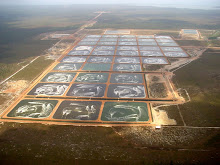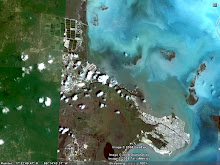The study of encrustations, biofilms, periphtyon, aufwucs and colonization is as complex and detailed as any in ecology.
We won't learn everything about this topic, but we can learn enough to be ready to deal with whatever we find on our aquamats, pvc poles, oyster strings or whatever other material we set out in the effluent canals.
Here's what a PVC pole looks like after just a few days in an effluent canal (this one was deployed in an estuary just downstream of the canals).

You can see the light brown glaze. That color indicates that the organisms growing here are probably mostly diatoms, a nutritious food that invertebrates love to eat.
Within about 3-6 weeks, the biomass on that pole will reach a "steady state" to which little biomass can be added. The total biomass of organisms will remain about the same from that point forward.
The same sized pole after 3 months in the water looks something like this....

The diatoms and the other nutritious diet items are still on the pole, but they have been joined by a wide variety of other organisms. The heavy lumps are barnacles. The dark green color comes mostly from blue green algae. Neither of those are desireable as food (although they may have other uses). Also colonizing the pole was a variety of worms, crabs and fishes (very small gobies were living inside some of the dead barnacle). Eggs of some organisms might also be attached.
Here are some questions for our groups to consider.
- How can we minimize the amount of harmful or competing organisms entering the ponds from the substrates (some organisms like crabs and fish are already in the ponds because they enter the ponds as eggs from the pump, but we should still probably think about how to minimize the things we don't want).
- How do we move large volumes of material off the substrates cheaply and without releasing the colonizing material back into the effluent canals?
- How much time should these substrates sit before they are "harvested"?
- What kind of data would we need to make these decisions scientifically?
Based on some coarse calculations, it seems we should be able to acheive significant reductions in the amount of nitrogen exiting the effluent canals (although I do need to correct an earlier assertion, apparently there are 30,000 Aquamats available, not 100,000).
Here's a link to a source that will tell you quite a bit about algae growing on attached surfaces. It may be useful to us here.




Hm...So it sounds to me as if the few-day old PVC pipe could be a possible food source for the shrimp? Assuming that I haven't got this wrong, would it be possible to have shrimp eat the diatoms off of the PVC pipe?
ReplyDeleteYes, you've got it.
ReplyDeleteSetting up PVC pipes in the canal and moving them up into the ponds or stripping the diatoms off them into the ponds would recycle nutrients into the pond and provide food for the shrimp.
But.
Would it be cost effective? Could those PVC pipes move enough food to pay for some one's time to move them back and forth and for the cost of the pipes?
If the process is cost effective, is it then optimally efficient?
How should the pipes be configured in the canal? Does PVC have advantages or disadvantages over Aquamats or other substrates? Is a pipe a good configuration for a substrate?
Hmmmm. Hmmmmm.